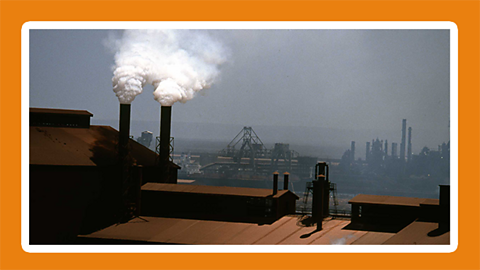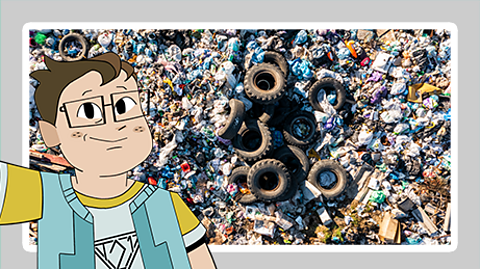
Welcome to The Regenerators.
Introduction
Clothes are important. They keep us dry and protect our skin from the sun. We wear different clothes to look smart, to blend in, and to stand out!
Making, moving and washing clothes uses land, water and energy. It also causes pollution.
But there are ways to get the clothes we need without harming the environment.
You've got a message!
It's Daz calling… from the future! He has an important message about taking care of your clothes and being smart about what you wear.
Daz: Hey people in the past. It's your pal Daz here again saying thanks for being smart about what you wear.
Did you know clothes grow on plants? Well, not really but some of them kind of do because cotton does. Cotton is used to make clothes - and one cotton t-shirt needs about 2700 litres of fresh water to make. That's about the amount of water you drink in the next five years.
But you realised we can't keep using all that fresh water when there's drinks to make and food to grow. So the smart thing you did was you bought less new clothes and when your clothes got damaged you got them repaired. Or you got super smart and fixed them yourself.
I'm making a fancy dress costume at the moment, I'm down here getting here materials for it. Apparently some people in your day bought whole outfits just to wear once and then never again.
Clothes were made. Oh, hi!
Animated Costume: "Alright Daz?"
Daz: Clothes were worn and clothes went to landfill.
Animated Costume: "Oh, rubbish."
Daz: But you lot, the best people ever, got your clothes in much smarter ways. Like for my costume I got my dad to download a secondhand clothes app and we found the trousers, and I swapped a blue T shirt for a friend's red one. I found some boots in a charity shop and I'm renting the mask and cape from the shop I am in now. And after I've looked awesome at the party these clothes will go back to make someone else look awesome.
You see in your day, most new clothes contained plastic. Yeah, really weird. Well, it's true. Plastic is bad news for the environment. It isn't biodegradable and when it goes in the washing machine tiny bits of plastic break off and go into rivers and oceans. So you wore your clothes more before you put them in the washing machine.
This saved so much water, plus, plus, plus! Getting your family to wash your clothes at a lower temperature saved energy too. So thank you for being awesome, for taking care of your clothes and being smart about what you wear. You are all heroes!
Where does the fabric in our clothes come from?
Lots of different fabrics are used to make clothes.
Explore the picture of Fatima to find out which fabrics she is wearing. Then check the labels on your own clothes.
All these fabrics are made using raw materials from our environment.
Cotton and viscose, wool and silk are produced on farms. This uses lots of land and water. Plastics such as polyester and acrylic are made from crude oil or natural gas. These are both Fossil fuelsNatural fuels such as coal, oil, or gas formed from the remains of plants, animals and other organisms that died millions of years ago..
How do clothes have an impact on the environment?
Turning raw materials into clothes uses energy. Transporting clothes to shops and homes uses energy. Washing, drying and ironing clothes uses energy too!
At the moment most of this energy comes from burning fossil fuels. This releases Greenhouse gasesGases such as water vapour, carbon dioxide and methane, in Earth’s atmosphere that trap heat. which causes global heating and climate change.
Making, transporting and washing clothes causes up to 10% of all the greenhouse gas emissions around the world each year.

Did you know?

Making one pair of jeans causes the same greenhouse gas emissions as driving 100km in a typical car.
Some pieces of clothing are only worn seven to ten times.
Most of the clothes we throw away end up in the bin. In the UK, 336,000 tonnes of clothing are sent to landfill every year.
This means that every second a rubbish truck full of fabric is buried in the ground or incinerateTo burn something, eg burning rubbish..
What a waste.


What is fast fashion?
The most common reasons for throwing away clothes are because they are damaged or because they don’t fit any more.
But there is another reason. It sounds strange, but many clothes are designed to become unfashionable!
By bringing in new styles every few weeks, shops make us think that we need to buy new clothes, again and again. This is called fast fashion.

Fast fashion leads people to stop wearing or even throw away perfectly good clothes. They buy clothes they don’t really need.
Every item has an impact on the environment. The good news is that we can tackle this problem and still look good.
Scientists and designers are looking for solutions, but you can help too.
What can we do?
Lesson complete
Well done Regenerator, you've completed this lesson. Now let's see what you can remember.
How to turn an old t-shirt into a bag
There are lots of ways to reuse old clothes in new ways.
Watch the video to find out how to turn an old t-shirt into a bag, then have a go yourself!
Don’t forget to ask an adult for help when using scissors as they are sharp. Check that it's okay to use the t-shirt.
This video has no words or dialogue, just music.
There's more to learn
Explore more lessons and content from around the В鶹ԼЕД.
How can we make tech better for the world?
GREEN CLASSROOM

How can we look after our environment?
GREEN CLASSROOM

Year 3 - 6 and P4 - P7
GREEN CLASSROOM

More from The Regenerators
В鶹ԼЕД BITESIZE
